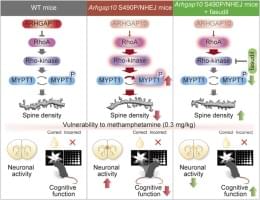Reversing schizophrenia with gene therapy year 2023.
Copy-number variations in the ARHGAP10 gene encoding Rho GTPase–activating protein 10 are associated with schizophrenia. Model mice (Arhgap10 S490P/NHEJ mice) that carry “double-hit” mutations in the Arhgap10 gene mimic the schizophrenia in a Japanese patient, exhibiting altered spine density, methamphetamine-induced cognitive dysfunction, and activation of RhoA/Rho-kinase signaling. However, it remains unclear whether the activation of RhoA/Rho-kinase signaling due to schizophrenia-associated Arhgap10 mutations causes the phenotypes of these model mice. Here, we investigated the effects of fasudil, a brain permeable Rho-kinase inhibitor, on altered spine density in the medial prefrontal cortex (mPFC) and on methamphetamine-induced cognitive impairment in a touchscreen‑based visual discrimination task in Arhgap10 S490P/NHEJ mice. Fasudil (20 mg/kg, intraperitoneal) suppressed the increased phosphorylation of myosin phosphatase–targeting subunit 1, a substrate of Rho-kinase, in the striatum and mPFC of Arhgap10 S490P/NHEJ mice. In addition, daily oral administration of fasudil (20 mg/kg/day) for 7 days ameliorated the reduced spine density of layer 2/3 pyramidal neurons in the mPFC. Moreover, fasudil (3–20 mg/kg, intraperitoneal) rescued the methamphetamine (0.3 mg/kg)-induced cognitive impairment of visual discrimination in Arhgap10 S490P/NHEJ mice. Our results suggest that Rho-kinase plays significant roles in the neuropathological changes in spine morphology and in the vulnerability of cognition to methamphetamine in mice with schizophrenia-associated Arhgap10 mutations.
